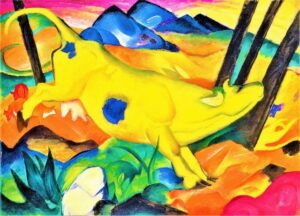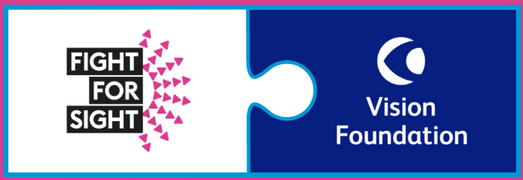In the bustling heart of Oxford Street, a unique art installation captures the essence of festivity and individuality. Clarke Reynolds, a Portsmouth-based visually impaired artist and long-standing Vision Foundation supporter, has brought an innovative perspective to Ask Italian through his latest creation—a snowflake braille window.
Clarke’s latest masterpiece not only adorns the popular Italian restaurant but also tells a story, the story of the Christmas menu, in a language understood through touch. The snowflake braille window at Ask Italian is an artistic endeavour but also a celebration of diversity. Each snowflake in the design is unique, symbolising the individuality of every person. This innovative approach enhances the aesthetic appeal of the restaurant and also serves as a poignant reminder of the inclusivity and accessibility that the holiday season should embody. Each braille snowflake, with its distinct pattern and texture, invites engagement and exploration, making the festive spirit truly accessible to all, regardless of visual ability.
A bit about the artist: Clarke Reynolds

Clarke Reynolds stands out on the creative scene with his distinctive approach to creating art. His journey into art, initially influenced by Franz Marc’s ‘The Yellow Cow’, was shaped by his limited sight and personal challenges. While, professionally Clarke worked as a dental model maker, his art was his passion and the occupier of his spare time. A significant shift occurred when he started losing sight in his other eye, prompting him to leave his job. During this period, he discovered textiles, using touch to reconnect with his creative process. Clarke began sewing with wool, layering it to create images, and using sound as his inspiration.
As Clarke Reynolds navigated the changes in his visual impairment, his artistic style evolved correspondingly. Initially influenced by the detailed art of pointillism, he adapted this technique to align with his shifting visual capabilities, incorporating dots to reflect his increasing reliance on tactile senses. This led to the innovative integration of Braille into his artwork, transforming text into a medium for expressive, visual storytelling. Clarke’s aim is to highlight visual impairment through his artistic language, hoping to be recognised as a transformative artist like Picasso.
His dedication to making art accessible through sound and touch, regardless of visual ability, underlines his commitment to inclusivity. Clarke’s story is not just about overcoming personal challenges, but about redefining artistic expression and impacting the art world significantly.

The Project
The snowflake braille window at Ask Italian is not just an artistic endeavour but a celebration of diversity. Each snowflake in the design is unique, symbolising the individuality of every person. Clarke’s intent is to blend this celebration of difference with a festive theme, creating an artwork that is both meaningful and seasonal. As the artwork comes to life, it offers a braille description of the restaurant’s Christmas menu, making the festive season more inclusive.
Reflections and Achievements of the Year
Clarke reflects on the year gone by as a blur of achievements and exciting projects. Engaging with thousands of visually impaired children has been a highlight, resonating with his mission to celebrate differences and embrace conditions with pride. The new studio in Portsmouth dockyards marks a new chapter in his artistic journey, coupled with an upcoming trip to India.
“This year has been a blur of exciting projects,” reflected Clarke when we spoke to him at the window’s unveiling. “I’ve engaged with so many visually impaired children as part of my work, which has been a real highlight.” Clarke has also recently taken up his artistic residence in Portsmouth Dockyards. “My new studio marks a new chapter in my artistic journey and I’ve got a trip to India coming up, which is bound to be full of experiences and connections that will influence my art…”
Of course that art already resonates deeply with the sight loss community, bringing joy to children in schools across the nation and serving as a unique bridge between the visually impaired and the vibrant world of colour and form. However, within the braille community, opinions on the artistic application of braille are diverse, presenting Clarke with interesting challenges. His art, reflecting the life experiences of a visually impaired person, not only advocates for the integration of braille in public spaces to enhance accessibility but also innovates, as seen in his incorporation of braille into Lego blocks.
This approach aims to make everyday life more inclusive. Additionally, Clarke’s work on the window installation at Ask Italian challenges common misconceptions about sight loss, fostering dialogue and awareness about the spectrum of visual impairment. His artistry, intertwined with his use of a cane, opens up important conversations and questions about the diverse experiences of those with sight loss.
Future Aspirations
The coming year holds more promise for Clarke, with plans to visit America and continue working with Quantus Gallery. He is particularly excited about designing the artwork to accompany the Fight for Sight / Vision Foundation’s new brand, which we’re thrilled to work with him on this year.
Clarke also has a dream project of designing braille building blocks for children, which seems to be coming to fruition. There was plans for the Tate Modern to showcase this by 2025; a clear reflection of his ambition and dedication to inclusivity and innovation in art.
The reaction of the sight loss community to Clarke’s art has been predominantly positive. His school workshops across the country have brought smiles to children’s faces, emphasising the importance of reaching out to young audiences. However, Clarke acknowledges the complexities within the art world and the braille community. While he views the white cane as a symbol of pride and incorporates vibrant colours into his braille-based art, some in the braille community have expressed reservations about using braille in such a colourful and artistic manner. These differing opinions highlight the diverse perspectives within the community regarding the artistic representation of braille.
You definitely can’t argue that through his art, Clarke continues to challenge perceptions, inspire change, and weave stories that resonate with both the sighted and the visually impaired.

